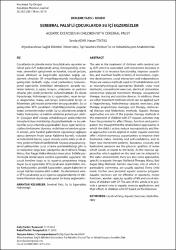| dc.contributor.author | Adar, Sevda | |
| dc.contributor.author | Toktaş, Hasan | |
| dc.date.accessioned | 2021-05-05T22:17:32Z | |
| dc.date.available | 2021-05-05T22:17:32Z | |
| dc.date.issued | 2019 | |
| dc.identifier.issn | 1302-4612 | |
| dc.identifier.issn | 2149-7869 | |
| dc.identifier.uri | https://app.trdizin.gov.tr/makale/TXpjeE5EazRPQT09 | |
| dc.identifier.uri | https://hdl.handle.net/20.500.12933/805 | |
| dc.description.abstract | Çocuklarda ön planda motor bozukluklarla seyreden serebral palsi (SP) tedavisinde amaç, fonksiyonelliği arttırmak, yetenekleri geliştirmek ve hareket, bilişsel gelişim, sosyal etkileşim ve bağımsızlık açısından sağlığı sürdürmek olmalıdır. SP rehabilitasyonunda nörofizyolojik yaklaşımlar (bobath, vojta, rood yöntemleri), konvansiyonel egzersizler, elektriksel stimulasyon, zorunlu kullanım tedavisi, iş uğraşı terapisi, ortezleme ve yardımcı cihazlar gibi çeşitli yöntemler kullanılmaktadır. Ek olarak hippoterapi, hidroterapi (su içi egzersizler), oyun terapisi, akupunktur, masaj, suit terapi, kraniosakral terapi ve feldenkrais gibi tedavi yöntemleri de uygulanabilir. Su içi yaklaşımlar SP’li çocukların rehabilitasyonunda popüler tedavi yöntemlerinden biridir. Su içi aktivitelerin zindelik halini, fonksiyonu ve katılımı etkileme potansiyeli olabilir. Çocuğun aktif olduğu rehabilitasyon yaklaşımlarının nöroplastisiteyi indüklediği düşünülmektedir ve bu yaklaşımlar su içi ortamda uygulanabilir. Su içi egzersizler çocuklara fonksiyonel durumu, mobiliteyi ve kendine güveni artıran, yeni hareket paternlerini öğrenmeyi sağlayan sayısız deneyim fırsatı sunar. Kaldırma kuvveti, viskozite ve hidrostatik basınç suyun vücudu asiste eden ya da direnç gösteren fiziksel özellikleridir. Karada uygulanan egzersiz yaklaşımları su içi ortama uyarlanabileceği gibi su içi tedavilere özgü bazı yaklaşımlar da (Halliwick Terapi, Watsu, Bad Ragaz Halka Metodu) mevcuttur. Sıklıkla yüzme başta olmak üzere aerobik egzersizler uygulanır. Her çocuk kendine özgü su içi egzersiz programına ihtiyaç duyar. Su içi egzersizler SP’li çocukların spastisiteleri, motor fonksiyonları, aerobik kapasiteleri, yaşam kaliteleri ve sosyal ilişkileri üzerine etkili olabilir. Bu derlemenin amacı SP’li çocuklarda su içi egzersiz uygulamalarına ve etkilerine literatüre dayalı olarak genel bir bakış sağlamaktır. | en_US |
| dc.description.abstract | The aim in the treatment of children with cerebral palsy (CP) which is associated with movement disorders in particular is to increase functionality, improve capabilities, and maintain health in terms of locomotion, cognitive development, social interaction and independence. There are various methods used in CP rehabilitation such as neurophysiological approaches (bobath, vojta, rood methods), conventional exercises, electrical stimulation, constrained induced movement therapy, occupational therapy, bracing and assistive devices. In addition, there are other treatment methods which can be applied such as hippotherapy, hydrotherapy (aquatic exercises), play therapy, acupuncture, massage, suit therapy, craniosacral therapy and feldenkrais methods. Aquatic therapy approaches are one of the popular therapy methods in the treatment of children with CP. Aquatic activities may have the potential to affect fitness, function and participation. It is thought that the rehabilitation approaches in which the child is active, induce neuroplasticity and these approaches can be applied in water. Aquatic exercises offer children numerous opportunities to improve their functional status, mobility and self-confidence, and to learn new movement patterns. Buoyancy, viscosity and hydrostatic pressure are the physical qualities of water which assists or resists to the body. As the exercise approaches which applied on the land can be adapted to the water environment, there are also some approaches specific to aquatic therapy (Halliwick Therapy, Watsu, Bad Ragaz Ring Method). Aerobic exercises, one of which is particularly swimming, are usually applied. Every child needs his/her own personel aquatic exercise program. Aquatic exercises can be effective in spasticity, motor functions, aerobic capacity, quality of life and social relations of children with CP. The aim of this article is to provide a general view to aquatic exercise applications and their effects in children with CP based on the literature. | en_US |
| dc.language.iso | tr | |
| dc.relation.ispartof | Kocatepe Tıp Dergisi | |
| dc.rights | info:eu-repo/semantics/openAccess | en_US |
| dc.subject | [No Keywords] | en_US |
| dc.title | SEREBRAL PALSİ’Lİ ÇOCUKLARDA SU İÇİ EGZERSİZLER | en_US |
| dc.title.alternative | AQUATIC EXERCISES IN CHILDREN WITH CEREBRAL PALSY | en_US |
| dc.type | Article | |
| dc.department | AFSÜ, Tıp Fakültesi, Dahili Tıp Bilimleri Bölümü, Fizik Tedavi ve Rehabilitasyon Ana Bilim Dalı | en_US |
| dc.institutionauthor | Adar, Sevda | |
| dc.institutionauthor | Toktaş, Hasan | |
| dc.identifier.volume | 20 | en_US |
| dc.identifier.issue | 4 | en_US |
| dc.identifier.startpage | 282 | en_US |
| dc.identifier.endpage | 288 | en_US |
| dc.relation.publicationcategory | Makale - Ulusal Hakemli Dergi - Kurum Öğretim Elemanı | en_US |
| dc.indekslendigikaynak | TR-Dizin | |
















